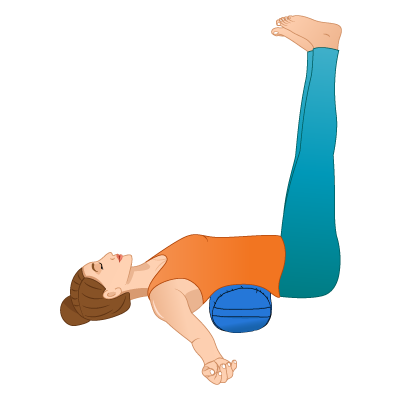Legs Up The Wall Pose
Viparita Karani

STEPS
Legs Up The Wall pose is a passive and supported version of Shoulderstand, utilizing bolsters or several folded blankets to create a support for the back. This passive pose allows for full relaxation and is an excellent aide in relieving back pains and insomnia.
Begin seated with your support 6 inches away from the wall. Allow your right hip to rest close to the wall and with an exhale slowly swing the legs up the wall. Gently wedge your support beneath the back, moving it until you find the best positioning for your body. The low back should have a small arc that is not over pronounced. Soften the throat and surrounding muscles of the neck while allowing your gaze to be parallel to the ceiling. The legs should be extended up the wall with a softness to the muscles. Hold for anywhere from 5 to 15 minutes before slowly removing the support and coming to one side. Remain on one side for 2 minutes before getting up.
TEACHER QUEUES
VISUALIZATION COMMENTS
Imagine a softness spreading across the body. This pose is meant to capture complete relaxation. Imagine the body melting into the support like candle wax, creating a softness everywhere. The legs should remain soft while supporting their upright nature.
TECHNICAL COMMENTS
The sitting bones don’t need to be again the wall. However, they should be resting into the space between the support and wall. Legs should remain firm enough to stay upright without being strained. The remainder of the body should be relaxed and soft without strain to achieve overall relaxation. Adjusting the support to meet your individual flexibility is important as those that have a stiff back may need the support further up the spine versus more flexible individuals will benefit from having the support further down the back towards the wall.
BENEFIT COMMENTS
- Relieve back pain
- Gently stretches the backs of the legs and neck
- Calms the mind
- Relieves leg and foot cramps
WATCH OUT FOR
- Neck strain
- Loss of sensation in the feet or legs, if any tingling occurs gently release from the posture
- Do not lock the knees
- Overly arching the back will lead to additional back pain
CONTRAINDICATIONS
- Do not practice this posture if you have glaucoma
- Avoid if you have neck and spine issues
MODIFICATIONS
- Place a strap around the thighs just above the knees to act as a support and guide for the legs
- If pregnant, modify by placing your props in a T shap for support beneath your upper back allowing your hips to rest evenly on the ground. Being sure to keep your head and heart elevated above your hips.
VARIATIONS
- Unsupported legs up the wall
- Wide Leg Variation – Allowing the legs to widen against the wall
YOGA COUNTER POSES
- Child’s Pose (Balasana)
Written By: Bre
Bre is an RYT 500 yoga teacher and wellness writer. Find out more about Bre at www.brenourse.com



